
Как открыть Forex брокера в 2025 году?
В статье
Открытие брокера на рынке Forex в 2025 году требует стратегического планирования, строгого соблюдения нормативных требований, современных технологий и грамотного позиционирования на рынке. Если вы изучите эти аспекты и адаптируетесь к ним, это поможет прочно закрепиться на рынке Forex среди продвинутых торговых платформ, компетентных трейдеров и жесткой международной конкуренции.
Как запустить брокера на рынке Forex за 12 шагов:
- Определите целевой рынок
- Сформулируйте бизнес-план
- Определитесь с типом брокера
- Выберите юрисдикцию и приобретите лицензию
- Выберите торговую платформу
- Обеспечьте компанию бэк-офисом
- Решите потребность в ликвидности
- Интегрируйте платежные решения
- Внедрите регламенты по управлению рисками
- Разработайте партнерскую программу
- Разработайте маркетинговую стратегию
- Начните привлечение клиентов
Теперь рассмотрим каждый шаг подробнее.
Определите целевой рынок
Начните с тщательного исследования рынка. Определите основные типы трейдеров в своем регионе — новичков, опытных профессионалов или институциональных клиентов — и обратите внимание на их приоритеты. Первоначальная классификация задаст направление для последующих действий.
Демография и торговые предпочтения
Сопоставьте возможности платформы с профилем аудитории. Молодые, следящие за технологиями пользователи предпочитают мобильную торговлю и инструменты автоматизации, а более опытные трейдеры часто ценят рыночную аналитику, стабильное исполнение ордеров и широкий выбор валютных пар.
Формирования вашего предложения
Используйте собранные вами данные для настройки платформы и сервисов. Для новичков предусмотрены учебные материалы и понятный интерфейс. Для продвинутых пользователей открыты сложные инструменты анализа, построения графиков и редкие валютные инструменты. Приведите каждый элемент в соответствие с потребностями аудитории.
Оценка местных нормативных актов и культурных факторов
В каждом регионе изучайте языковые потребности, местные правила, расписание праздников и принятое в культуре отношение к риску. Локализация контента и соответствие местным нормативам могут повысить доверие и привлечь пользователей, которые чувствуют, что их уникальный контекст понят.
Оценка конкуренции и уникальности предложения
Определите существующих брокеров, которые работают с вашей целевой группой. Обратите внимание на их цены, а также сильные и слабые стороны. Сделайте свою брокерскую компанию уникальной, предложив лучший пользовательский опыт, более оперативную поддержку или уникальные торговые возможности, которые заполнят пробелы, не закрытые конкурентами.
Предпочитаемые способы оплаты и каналы поддержки
Изучите, как ваша аудитория обычно вносит и снимает средства — с помощью кредитных карт, местных электронных кошельков, банковских переводов, — а затем интегрируйте эти методы. Выберите каналы поддержки клиентов (чат, email, телефон), которые соответствуют ожиданиям клиентов с точки зрения скорости и удобства.
Составьте бизнес-план
Точно укажите, что вам нужно —присутствие на нишевом рынке, акцент на крупных трейдерах или предложение специализированных валютных пар. Определите измеряемые цели: целевую норму прибыли в течение 24 месяцев или определенное количество активных клиентов в конце первого года.
Финансовые прогнозы и составление бюджета
Опишите все затраты на запуск, в том числе лицензии, технологические решения, нормативные сборы и стартовые маркетинговые кампании, а также детализируйте текущие расходы, например, заработную плату персоналу, обслуживание платформы и затраты на ликвидность. Создавайте реалистичные прогнозы по выручке на основе спредов, комиссий и дополнительных услуг, а также учитывайте различные рыночные условия — периоды волатильности могут увеличить объем торгов, а спокойные периоды могут снизить прибыль.
Позиционирование и дифференциация на рынке
Изучите конкурентную среду и определите, чем будете выделяться. Возможно, вы сосредоточитесь на исключительной поддержке клиентов, уникальных валютных предложениях, образовательных ресурсах или передовых аналитических инструментах.
Масштабируемость и адаптивность
Планируйте рост и изменение рыночных условий, создавая гибкую инфраструктуру и процессы. Выбирайте платформы, которые могут обрабатывать более высокие объемы торгов и легко интегрировать новые инструменты, а также поддерживать систему нормативного контроля, которую можно корректировать по мере изменения нормативных актов.
Доверие инвесторов и стейкхолдеров
Инвесторов, партнеров и потенциальных кредиторов убеждают с помощью хорошо составленного плана компании, который отражает результаты вашей аналитики. Им нужно показать, что знаете, как преодолеть трудности, учли операционные сложности, финансовые риски и юридические ограничения.
Определитесь с типом брокера
Выбор операционной модели для вашего Forex-брокера повлияет на распределение рисков, поток доходов и позиционирование на рынке Forex-индустрии. По разным функциям и подходам к работе отличают три основные модели: A-Book, B-Book и гибридную.
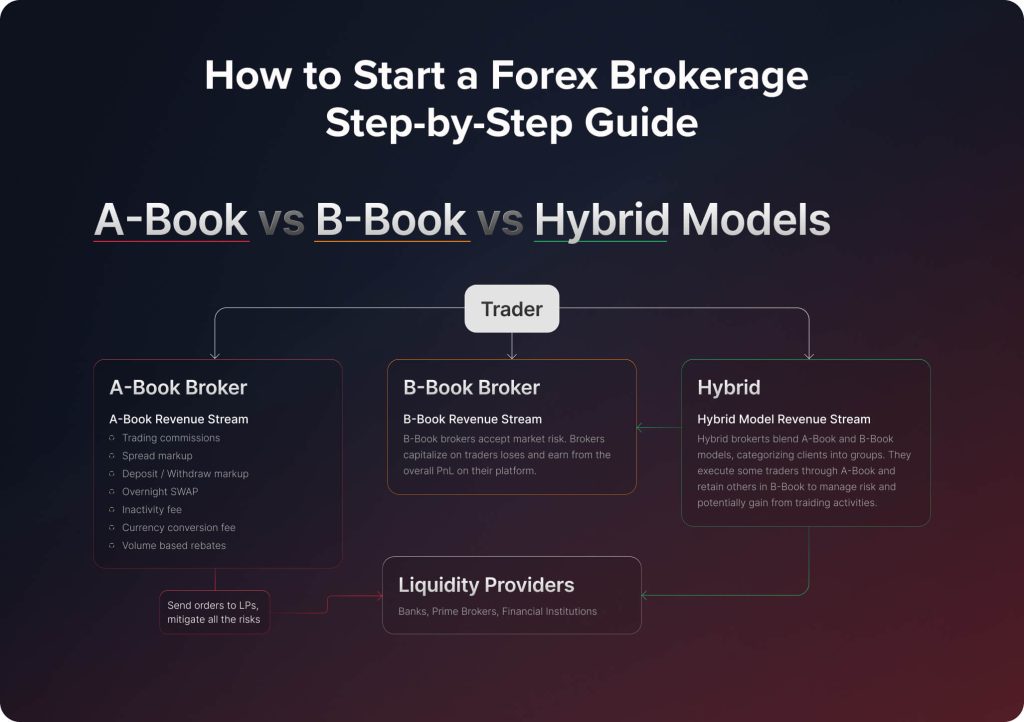
A-Book брокер
Источник дохода у A-Book
- Комиссии за сделки
- Наценки на спреды
- Сбор за ввод/вывод средств
- Ночной своп
- Комиссия за неактивность
- Комиссия за конвертацию валюты
- Возвраты в зависимости от объема
Брокер B-Book
Источник дохода у B-Book
B-Book брокеры принимают рыночные риски. Их платформы зарабатывают на убытках трейдеров и на общем соотношении доходов и убытков.
Гибридная модель
Источник дохода гибридной модели
Гибридные брокеры сочетают модели A-Book и B-Book, разделяя клиентов на группы. Чтобы распределять риски и зарабатывать на торговле, некоторых трейдеров они привлекают по A-Book, а других удерживают по B-Book.
Отправляйте ордера поставщикам ликвидности, снижайте возможные риски
Поставщики ликвидности
Банки, прайм-брокеры, финансовые организации
Рекомендации по использованию модели A-Book
В модели A-Book ваша роль Forex-брокера похожа на роль посредника. Вы передаете сделки ваших клиентов непосредственно поставщикам ликвидности или на межбанковский рынок. Эту модель хвалят за прозрачность, которая позволяет согласовать интересы брокера и клиентов. Получение дохода в основном за счет комиссий и спредов требует прочных связей с авторитетными поставщиками ликвидности, поскольку необходимо гарантировать конкурентные цены и исполнение сделок для трейдеров. Однако эта модель требует глубокого понимания ликвидности на валютном рынке и надежной технологической инфраструктуры для эффективного совершения сделок.
Работа модели B-Book
Модель B-Book представляет собой другой подход, при котором вы принимаете на себя риск, выступая в качестве контрагента по сделкам клиентов. В этом случае прибыльность зависит от торговых убытков клиентов, что создает ситуацию, при которой интересы брокера могут расходиться с клиентскими. Эта модель обеспечивает контроль над торговыми операциями и может быть прибыльной, если вы хорошо разбираетесь в рыночных трендах и поведении клиентов. Однако это она также сопряжено с более высоким риском и требует отличных стратегий управления рисками и аналитических инструментов, позволяющих сбалансировать потенциальные убытки и выгоды.
Гибкость гибридной модели
Сочетая в себе идеи A-Book и B-Book, гибридная модель обеспечивает адаптивность и разные источники дохода. В зависимости от оценки рисков каждой клиентской транзакции, она позволяет вам направлять некоторых из них внешним поставщикам ликвидности (A-Book), а других удерживать у себя (B-Book). Эта модель позволяет эффективно управлять рисками за счет диверсификации торговых рисков. Внедрение гибридной модели требует продвинутых систем для точного анализа и категоризации сделок, а также тонкого понимания различных торговых стратегий и связанных с ними рисков.
Выбор модели A-Book, B-Book или гибрида должен зависеть от конкретных целей вашего брокера, возможности управления рисками и предпочтений целевой аудитории на рынке. У каждой модели свои преимущества и недостатки; выбор наилучшей для ваших Forex-трейдеров будет зависеть от того, насколько она соответствует их требованиям и общей стратегии вашей компании.
Выберите юрисдикцию и приобретите лицензию
Создание Forex-брокера требует принятия важного решения: выбора юрисдикции и получения лицензии. Этот шаг имеет основополагающее значение для соблюдения законодательства и установления доверия и легитимности в глазах Forex-трейдеров и на финансовых рынках в целом.
Разбираемся в нормативно-правовой базе и выбираем юрисдикцию
Открытие брокерской компании на рынке Forex требует принятия важного решения о юрисдикции и соблюдении нормативных требований. Хотя такие авторитетные органы, как Австралийская комиссия по ценным бумагам и инвестициям (ASIC) или Управление финансового контроля Великобритании (FCA), имеют отличную репутацию, получение их лицензий может быть затруднено, особенно для небольших или новых брокеров. Эта проблема заставляет многих рассматривать альтернативные варианты в оффшорных юрисдикциях.
Изучаем оффшорные юрисдикции в качестве альтернатив
Оффшорные юрисдикции часто предоставляют более доступную точку входа для новых Forex-брокеров. Хотя они могут и не обладать таким престижем, как FCA или ASIC, но обладают рядом практических преимуществ:
- Упрощенный процесс лицензирования: оффшорные юрисдикции, как правило, отличаются более простым и быстрым процессом лицензирования, что может иметь решающее значение для брокерских компаний, стремящихся выйти на рынок без длительных задержек.
- Экономическая эффективность: для стартапов или небольших компаний оффшор может быть более выгодным с финансовой точки зрения, поскольку расходы на получение и хранение разрешений в оффшорных странах обычно меньше.
- Гибкое регулирование: обычно в этих странах действуют мягкие правила, которые предоставляют брокерским компаниям большую свободу действий и менее строго следят за нормативным контролем.
- Доступ к глобальному рынку: оффшорные лицензии по-прежнему обеспечивают доступ к широкому спектру зарубежных рынков, что позволяет брокерским компаниям обслуживать разнообразную клиентскую базу.
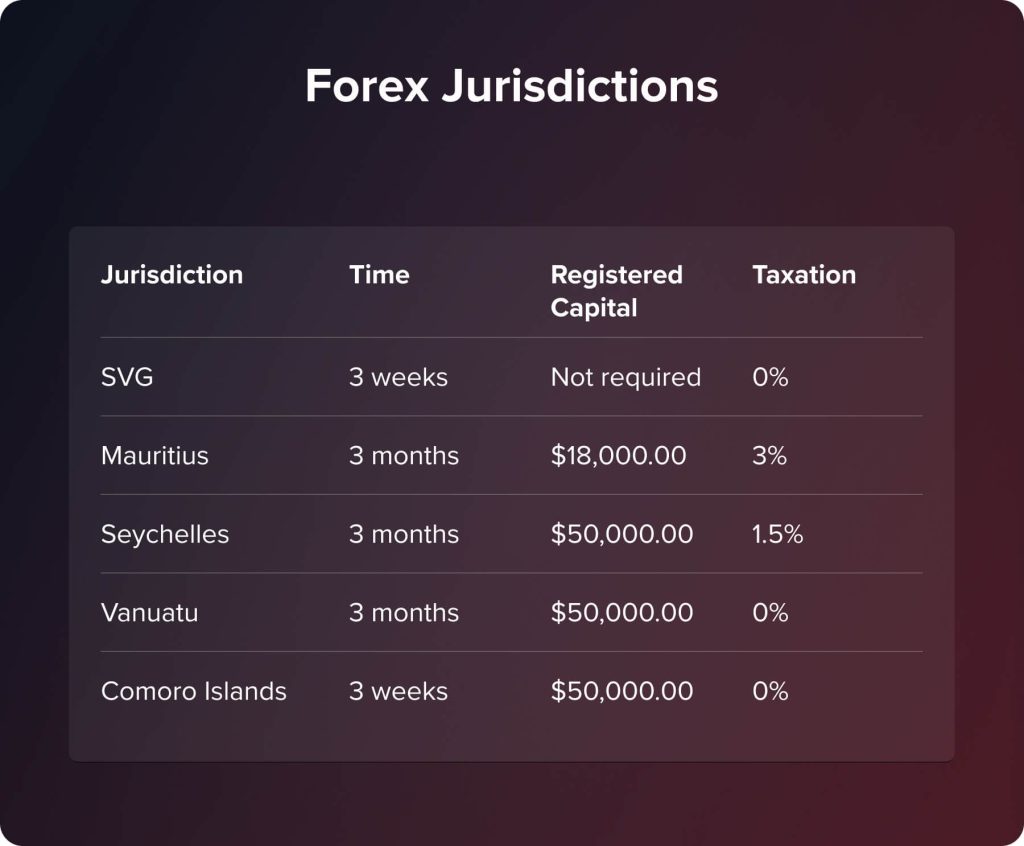
Процесс лицензирования
Получение лицензии Forex-брокера — это долгая и сложная процедура. Она подразумевает соответствие определенным юридическим критериям, подтверждение финансовой стабильности, внедрение разумной политики контроля рисков и обеспечение того, чтобы управленческая команда обладала необходимыми знаниями и полномочиями. Наряду с этим, процедура включает в себя подготовку и сдачу полного пакета документов, а также их тщательное рассмотрение властями.
Юрисдикция существенно повлияет на время и расходы, связанные с получением лицензии Forex-брокера. Эти сборы включают судебные издержки, лицензионные сборы, текущие расходы, необходимые, чтобы обеспечить соответствие вашей компании требованиям законодательства. Поэтому следует включить эти расходы в первоначальный бизнес-план и быть готовыми потратить время.
Привлечение профессионального консультанта может быть чрезвычайно полезным, учитывая сложность регулирования рынка Forex и процесса лицензирования. Юридические эксперты и специализированные консалтинговые фирмы могут предоставить ценную информацию и поддержку, помогая упростить процесс подачи заявки, обеспечить соблюдение нормативных стандартов и, возможно, ускорить получение вашей Forex-лицензии.
Выберите торговую платформу
Выбор подходящей торговой платформы имеет решающее значение в запуске Forex-брокера. Эта платформа — не просто инструмент, а шлюз, через который ваши клиенты будут взаимодействовать с динамичным валютным рынком. Это решение предполагает тщательную оценку различных платформ с учетом их особенностей, надежности и удобства использования, а также сопоставление этих факторов с техническими характеристиками, имеющими решающее значение для бесперебойной и эффективной торговли.
Оцениваем торговые платформы
Рынок Forex предлагает целый ряд систем с особыми преимуществами. Во многом благодаря своей доказанной надежности, широким возможностям и общему признанию среди трейдеров, такие популярные ресурсы, как MetaTrader, обычно выбирают многие брокеры. MetaTrader 4 и MetaTrader 5 предлагают сложные торговые инструменты, возможность настройки и полезное сообщество пользователей как начинающим, так и опытным трейдерам.
Однако, хотя MetaTrader долгое время занимал доминирующее положение на рынке, все чаще он воспринимается как нечто устаревшее, особенно в свете появления новых, более технологичных платформ. По мере развития рынка трейдеры ищут платформы с более современным интерфейсом, расширенными функциями и более развитой интеграцией. В этом контексте все большее внимание привлекают такие торговые платформы, как Quadcode. Эти современные платформы разработаны с использованием передовых технологий и предлагают различные функции за рамками традиционной торговли. Они предоставляют удобный пользовательский интерфейс, передовые аналитические инструменты и спектр настроек, которые позволят реализовать запросы современных трейдеров.
Кроме того, некоторые брокеры выбирают разработку собственной торговой платформы. Эта опция делает возможной дополнительную кастомизацию, тем самым приводя платформу в соответствие с конкретными требованиями заказчика или рыночной нишей. Собственные платформы требуют значительных технологических инвестиций и постоянного развития, чтобы идти в ногу с меняющейся отраслью, даже если они могут обеспечить различные конкурентные преимущества и особые продающие факторы. Появление таких решений, как Quadcode Brokerage Solutions, демонстрирует изменения в секторе, где от инноваций и модернизаций зависит привлечение нового поколения трейдеров, которые ищут большего, чем предоставляют традиционные платформы.
Рекомендации по техническим характеристикам
Чтобы повысить вовлеченность клиентов и эффективность торговли, при выборе торговой платформы уделяйте первоочередное внимание техническим критериям и удобству для пользователей. Широкие возможности платформы должны помочь улучшить взаимодействие с пользователями и повысить вовлеченность, что напрямую повлияет на средний доход на одного пользователя (ARPU) и жизненный цикл клиента (LTV).
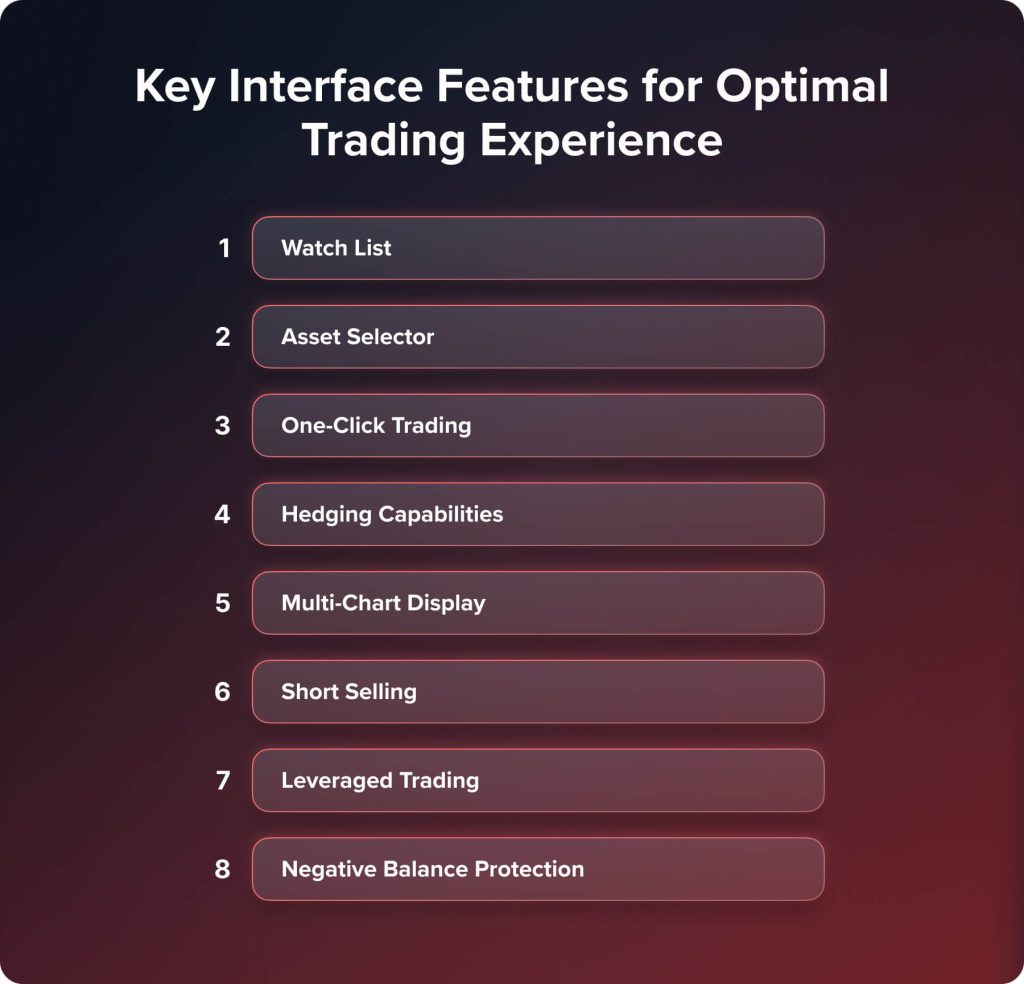
Многофункциональность и техническое совершенство
Выбранная торговая платформа должна быть реализована технически безупречно и обладать богатыми функциональными возможностями. Хотя такие факторы, как скорость исполнения, часто связаны с поставщиками ликвидности или внутренними дилинговыми механизмами, способность платформы бесперебойно обеспечивать эти операции имеет жизненно важное значение. Она должна быть способна эффективно обрабатывать большие объемы сделок и предлагать надежные возможности интеграции с другими ключевыми системами — поставщиками ликвидности, решениями для бэк-офиса и сервисами обработки платежей.
Выбор подходящей торговой платформы заключается в том, чтобы найти баланс между превосходными техническими характеристиками и многофункциональным пользовательским интерфейсом. В конечном счете, платформа должна соответствовать вашим стратегическим целям, удовлетворять потребности целевого рынка и быть частью согласованной операционной среды, способствуя вовлеченности клиентов и развитию компании.
Обеспечьте компанию бэк-офисом
При создании успешного Forex-брокер выбор подходящего решения для бэк-офиса имеет первостепенное значение. Это решение служит операционным ядром вашего бизнеса, влияя на все — от управления клиентами до финансовой отчетности. Правильно подобранная система бэк-офиса обеспечивает операционную эффективность и надежную функциональность, что имеет решающее значение для бесперебойной работы различных бизнес-процессов.
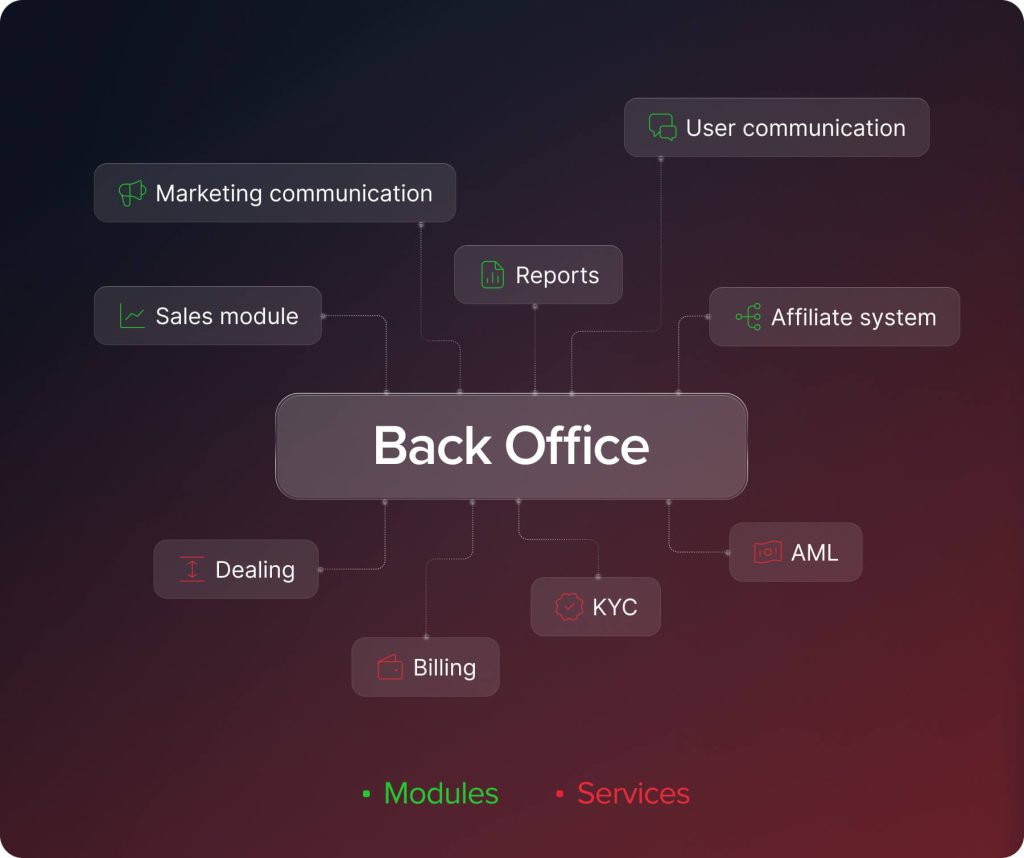
Ключевые модули и сервисы эффективной системы бэк-офиса
Комплексная система бэк-офиса для Forex-брокера должна включать в себя ряд модулей, каждый из которых отвечает конкретной операционной потребности:
- Коммуникация с пользователями: платформа для общения с клиентами в реальном времени, которая упрощает коммуникацию, работу с запросами, и повышает качество обслуживания клиентов.
- Модули продаж: инструменты для отслеживания продаж, управления пользователями и увеличения их вовлечености, имеющих решающее значение для стимулирования роста бизнеса.
- Отчеты: расширенные возможности создания отчетов позволяют получить четкое представление о бизнес-операциях, включая торговлю, активность клиентов и финансовые отчеты, что помогает принимать информированные решения.
- Маркетинговые коммуникации: интегрированные маркетинговые инструменты для проведения эффективных кампаний, управления рекламными акциями и взаимодействия с потенциальными и существующими клиентами.
- Партнерские системы: система управления и отслеживания эффективности работы партнеров, которая обеспечивает точное распределение вознаграждений и способствует развитию взаимовыгодных партнерских отношений.
- Дилинг: инструменты для управления торговой деятельностью, в том числе исполнением ордеров, управлением рисками и мониторингом рыночных позиций.
- Выставление счетов: эффективная обработка всех счетов и финансовых транзакций, обеспечение точности выставления счетов, платежей и финансовой выверки.
- Соответствие требованиям KYC и AML: комплексные модули для процедур по борьбе с отмыванием денег и валидации клиентов гарантируют соблюдение нормативных требований и помогают снизить риски.
По сути, для Forex-брокера полноценная система бэк-офиса со всеми этими важными компонентами является стратегическим преимуществом, а не просто необходимостью в бэкенде. Она гарантирует безупречную операционную эффективность и соответствие требованиям законодательства, тем самым предоставляя необходимые инструменты для эффективного управления компанией и взаимодействия с клиентами. Таким образом, выбор подходящей системы бэк-офиса оказывает существенное влияние на эффективность и пути расширения деятельности Forex-брокера.
Работа с потребностями в ликвидности
Удовлетворение потребностей в ликвидности — важнейший аспект создания Forex-брокера, который существенно влияет на качество обслуживания клиентов. Подход к обеспечению ликвидности зависит от брокерской модели — A-Book, B-Book или гибридной. Каждая модель требует своей стратегии управления ликвидностью и рисками.
A-Book и гибридные модели: необходимость в поставщиках ликвидности
Партнерство с авторитетными поставщиками ликвидности жизненно важно для брокерских компаний, работающих по A-Book и гибридной модели. Эти модели предполагают передачу клиентских ордеров непосредственно на межбанковский рынок или внешним поставщикам ликвидности.
- Партнерство с поставщиками ликвидности: обработка крупных пулов ликвидности зависит от прочных отношений с крупными банками или финансовыми организациями на межбанковском рынке. Это особенно важно для привлечения трейдеров, которые торгуют большими объемами или с высокой частотой, и гарантирует постоянный приток ликвидности и привлекательные спреды. Надежность этих поставщиков и скорость исполнения сделок сильно влияют на удобство работы для клиентов.
- Агрегаторы ликвидности: Использование сервисов агрегатора ликвидности помогает еще больше улучшить условия торговли. Собирая цены из нескольких источников, агрегаторы предоставляют больше конкуретных предложений по сделкам и более широкий спектр инструментов. В частности, на быстро меняющихся рынках они гарантирует клиентам максимально выгодные ставки.
Модель B-Book: фокус на управлении рисками
И наоборот, акцент смещается с поставщиков ликвидности на надежное управление рисками для брокерских компаний в соответствии с моделью B-Book. В этой модели брокерская компания выступает в качестве контрагента клиентским сделкам — она получает прибыль, когда клиенты теряют, и наоборот.
- Снижение зависимости от внешней ликвидности: брокеры B-Book не выводят сделки на внешние рынки; таким образом, потребность в поставщиках ликвидности значительно снижается. Основное внимание уделяется управлению внутренними рисками.
- Эффективные стратегии управления рисками: внедрение сложных систем управления рисками приобретает первостепенное значение. Сюда входит мониторинг торговой активности клиента, выявление подверженности риску и использование стратегий для балансировки сделок у брокера. Качественное управление рисками обеспечивает брокеру устойчивость, особенно когда клиенты получают прибыль.
То, как Forex-брокер удовлетворяет требования к ликвидности, тесно связано с установленными операционными принципами. Создание успешного Forex-брокера, который должным образом обслуживает своих клиентов, зависит от знания конкретных критериев выбранной модели и адаптации к ним.
Интеграция платежных решений
Один из ключевых компонентов, на который необходимо обратить внимание при создании Forex-брокера, — использование надежной и гибкой платежной системы. Это не просто удобно. Качество торговли ваших клиентов в значительной степени зависит от их способности быстро вносить и выводить деньги. Эффективность вашей платежной интеграции может существенно повлиять на удовлетворенность клиентов и стабильность работы.
Предложение линейки методов оплаты
Обслуживание клиентов по всему миру зависит от того, насколько вы диверсифицируете источники платежей. У каждого трейдера есть свои предпочтения и ограничения относительно методов оплаты. В особенности при крупных депозитах, рекомендуется сочетать множество способов оплаты, в том числе кредитные и дебетовые карты из-за их общей распространенности и удобства, электронные кошельки из-за скорости и простоты, а также обычные банковские переводы из-за их безопасности. Такое разнообразие гарантирует, что ваш брокер сможет удовлетворить требования и предпочтения трейдеров из разных стран и разным бекграундом, работая на пользу вашим предложениям.
Определение приоритетов в области безопасности и нормативного контроля
Что касается финансовых операций, особенно в таком активном секторе, как Forex-торговля, то вопросы безопасности и соблюдения нормативных требований не подлежат обсуждению. Защита средств и персональных данных клиентов в основном зависит от того, насколько ваши платежные решения соответствуют передовым стандартам безопасности, включая зашифрованные транзакции и строгие правила защиты данных. Кроме того, очень важно соблюдение локальных правил и международных норм, особенно при осуществлении трансграничных операций. Сюда входит гарантия открытости всех финансовых операций и соблюдение AML-процедур. Сотрудничество с надежными поставщиками платежных услуг поможет справиться с этими сложностями, поскольку они предоставляют безопасные и соответствующие нормативному регулированию решения по транзакциям, которые отвечают многочисленным требованиям клиентов по всему миру.
Успешная интеграция разнообразных, безопасных и совместимых платежных решений — ключевой момент в создании вашего собственного брокерского бизнеса на рынке Forex. Имеется в виду не только множество способов проведения финансовых операций, но и создание атмосферы, в которой клиенты чувствуют себя уверенно и защищенно при работе с вашим брокером. Хорошо продуманная платежная система может значительно повысить доверие клиентов, их удовлетворенность и, в конечном счете, репутацию компании и успех вашего Forex-брокера.
Внедрение протоколов управления рисками
В сложном мире Forex-брокеров создание надежных регламентов управления рисками похоже на создание универсальной страховки для вашего брокерского бизнеса. Здесь предполагается тщательный подход к снижению различных рисков, от операционных до непосредственно связанных с торговой деятельностью.
Разработка стратегии защиты от торговых рисков
Торговля на рынке Forex сопряжена с рисками для контрагентов и естественными скачками рыночной волатильности. У вашего брокера должны иметь гибкие и надежные стратегии управления рисками, если вы хотите закрепиться этой сфере. Методы могут включать установление разумных пределов кредитного плеча для клиентов, что позволит защитить брокера и их самих от серьезных рисков, связанных со слишком высоким кредитным плечом. Еще одна разновидность риска — риск контрагента, когда постоянно есть вероятность неисполнения обязательств противоположной стороной, участвующей в сделке. Снижение этого риска требует тщательного изучения всех причастных сторон, в том числе поставщиков ликвидности, и заключения соглашений по защите брокера от любых финансовых потрясений.
Устранение операционных рисков
Операционные риски в брокерском бизнесе на рынке Forex распространяются на разные сферы. Например, технологические сбои могут привести к сбоям торговых операций, что приведет к недовольству клиентов и убыткам. Поэтому нужна надежная IT-инфраструктура, укрепленная средствами защиты от сбоев и планом действий в чрезвычайных ситуациях. Часть этой защиты, которая гарантирует, что технологические сбои не помешают торговле — это регулярное техническое обслуживание и обновление системы.
Кибербезопасность — еще одна область, которая требует постоянного внимания в современную цифровую эпоху. Управление конфиденциальной информацией о клиентах и крупными финансовыми транзакциями ставит Forex-брокера непосредственно в центр внимания у хакеров. Создать защиту вокруг ваших цифровых активов означает использовать передовые инструментов кибербезопасности: регулярные аудиты защитных систем, шифрование и брандмауэры для предотвращения возможных кибератак.
Нормативно-правовая база в торговле на рынке Forex очень сложна и постоянно меняется. Поддержание культуры нормативного контроля в вашей компании и отслеживание изменений в законодательстве помогут опережать проблемы, связанные с соблюдением юридических требований. К этому относится постоянное обучение персонала процедурам нормативного контроля, а также постоянная оценка и совершенствование внутреннего регламента в соответствии с меняющимися правовыми требованиями.
Создание надежной системы управления рисками у Forex-брокера — это построение защищенной среды, которая будет противостоять многочисленным угрозам рынка. Выверенное сочетание инициатив по укреплению операционной инфраструктуры и формированию культуры работы с рисками влияет на вашу компанию на всех уровнях.
Разработка партнерской программы
При создании надежного партнерского модуля для Forex-брокера ключевой компонент — создание влиятельной партнерской сети физических и юридических лиц в финансовом секторе. В эту сеть могут входить влиятельные лица, преподаватели в сфере торговли и другие ключевые игроки, каждый из которых способен расширить охват и повысить доверие к вашему брокеру. Помимо создания этих прочных связей, следует также принимать во внимание множество вариантов выплат от брокера партнерам. Эти модели дают множество уникальных преимуществ и стимулов, которые включают затраты на приобретение (CPA), долю дохода и долю спреда.
Использование потенциала партнерских сетей
Главное в успешном партнерском модуле — наладить продуктивные отношения с физическими и юридическими лицами, которые занимают лидирующие позиции в финансовом мире. Инфлюенсеры и преподаватели торговли со своей целевой аудиторией могут стать влиятельными проводниками маркетинговых усилий вашего брокера. Главное — выявить и начать сотрудничество с партнерами, чьи подписчики соотносятся с целевой аудиторией. Например, преподаватель, за которым следуют начинающие трейдеры, может стать бесценным активом для брокера, ориентированного на новичков рынка Forex.
Эти партнерские отношения выходят за рамки простого продвижения; они повышают доверие к брокеру. Когда уважаемые представители финансового сообщества ручаются за ваши услуги, это естественным образом повышает вашу привлекательность для потенциальных клиентов. Этот аспект доверия особенно важен на рынке Forex, где авторитет и репутация играют важную роль в принятии клиентами решений.
Различные модели компенсации
- CPA: в соответствии с этой моделью партнерам платят за каждого привлеченного клиента, который удовлетворяет определенным требованиям, например, депозит или минимальное число транзакций. Простой механизм гарантирует партнерам возврат средств за каждую соответствующую требованиям рекомендацию.
- Revshare: в соответствии с этой моделью торговая деятельность рекомендованных клиентов приносит часть общего дохода. Поскольку доходы партнера зависят от объема торговли клиента с течением времени, это мотивирует партнеров рекомендовать предположительно долгосрочных и активных трейдеров.
- Spread Share: как и в случае Revshare, партнеры получают вознаграждение за долю спреда в зависимости от объема торгов, полученного по их рекомендациям. На рынке Forex, где спреды определяют расходы на торговлю, этот вариант вызывает большой интерес.
Эффективный трекинг и проработанная структура компенсаций
Внедрение надежной системы трекинга имеет жизненно важное значение для эффективного управления действиями партнеров и их вознаграждения. Сюда входит создание прозрачного механизма для мониторинга рефералов, конверсий клиентов и других важных показателей, которые оценивают эффективность ваших партнерских отношений. Модель вознаграждения для ваших партнеров является важнейшим аспектом этой системы. Cтруктура должна подходить и партнерам, и вашему брокеру: это может быть модель, в которой партнеры получают долю прибыли от рефералов, или фиксированная оплата за определенные действия, например, регистрации клиентов.
Ключ к прибыльной партнерской программе заключается в соблюдении правильного баланса — предлагать конкурентные вознаграждения партнерам и одновременно обеспечивать прибыльность партнерских отношений для вашего брокера. Кроме того, важно поддерживать прозрачность, предоставлять данные в режиме реального времени и предоставлять четкую отчетность партнерам. Это укрепляет доверие и мотивирует их прикладывать усилия в продвижении ваших услуг.
В сущности, разработка партнерского модуля для своего Forex-брокера — это создание партнерской сети, которая расширит охват вашего бренда и усилит его присутствие на рынке. Хорошо структурированная партнерская программа, подкрепленная эффективным трекингом и достойными выплатами, может внести серьезный вклад в рост вашего брокера и его известность на конкурентном валютном рынке.
Разработайте маркетинговую стратегию
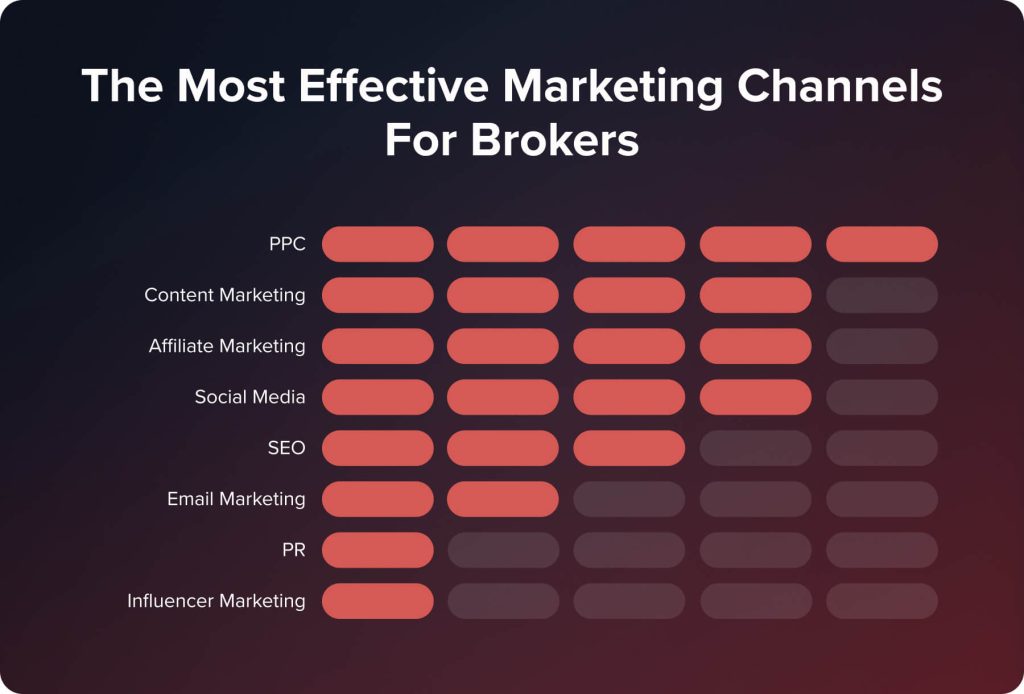
Создание полноценного маркетингового плана — сложная задача для Forex-компании, которая занята чем-то большим, чем обычное продвижение услуг. Речь идет о создании уверенной идентификации бренда, привлекательного для целевого рынка, а также использовании множества платформ digital-маркетинга для успешной коммуникации и продвижения.
Создание сильной идентичности бренда и позиционирование на рынке
Ваш маркетинговый план главным образом основан на создании уникальной идентификации бренда. Этот метод предполагает глубокий анализ ценностей вашей Forex-организации и желаемого позиционирования на рынке. Вы ориентируетесь на опытных трейдеров, привлекая их сложными торговыми инструментами и статистикой, или пытаетесь стать доступной платформой для новичков, предлагая простой интерфейс и развернутые учебные материалы? Каким бы ни был ваш профиль, бренд должен отражать эти идеи.
Единообразие во всех элементах брендинга, от визуального оформления, логотипов и верстки сайтов, до тона коммуникации, имеет решающее значение. Оно повышает узнаваемость и доверие среди ваших потенциальных клиентов. Знание своих конкурентов и собственных уникальных черт может помочь вам занять собственную нишу на рынке. Чем достигается уникальность — передовыми технологиями, разумной ценой или исключительным клиентским сервисом? Четкое представление об уникальном торговом предложении — ключ к тому, чтобы выделиться на насыщенном рынке Forex.
Использование digital-маркетинга для расширения охвата и вовлеченности
Заметное присутствие в интернете очень важно в современном цифровом пространстве. Хорошо продуманный план SEO-продвижения увеличит вашу представленность в интернете и узнаваемость, а также привлечет постоянных клиентов. Но на этом все не заканчивается; маркетинг в социальных сетях не менее важен. LinkedIn, Twitter и Instagram — это не просто инструменты для продвижения, а платформы, которые помогут найти контакт с аудиторией, создать сообщество и предоставить контент, который помогает торговать.
Email-маркетинг остается эффективным инструментом для установления прямой коммуникации с вашей аудиторией. Вы можете информировать своих клиентов и привлекать их к брокерским предложениям с помощью полезных информационных рассылок и новостей. Такие дополнительные методы digital-маркетинга, как PPC-реклама, контент-маркетинг и партнерство с инфлюенсерами, поможет привлекать больше клиентов.
С учетом всех факторов, хороший маркетинговый план для своего Forex-брокера — это гармоничное сочетание динамичного подхода к digital-маркетингу и четко определенной идентификации бренда. Речь идет о правильном позиционировании брокерской компании на рынке, привлечении и удержании нужных клиентов, а также о создании бренда, который будет привлекать трейдеров и пройдет проверку временем.
Инициируйте привлечение клиентов
Начало этапа привлечения клиентов имеет решающее значение для Forex-брокера и означает переход от настройки к активной работе. В соответствии с результатами вашего исследования рынка, этот этап заключается в привлечении новых клиентов и реализации хорошо продуманного плана, ориентированного на вашу целевую аудиторию. Внимание к удержанию клиентов не менее важно для этого процесса, поскольку оно гарантирует, что привлеченные клиенты всегда будут довольны вашими продуктами или сервисами.
Точный таргетинг на нужную аудиторию
Что касается привлечения клиентов, то успех ваших инициатив зависит от точного определения потенциальных клиентов. Знания о рыночной нише теперь должны определять направление ваших проектов по продвижению Например, если ваше исследование показывает, что существует спрос на платформу для неопытных трейдеров, в вашем маркетинге и коммуникации следует выделить такие элементы, как простота использования и обучающие инструменты. Секрет состоит в том, чтобы составить свое сообщение в соответствии с конкретными требованиями и вкусами целевой аудитории.
Двойная направленность на привлечение и удержание клиентов
Хотя расширять новый бизнес важно, жизнеспособность и расширение вашего брокера во многом зависят от умения удерживать клиентов. Удержание клиентов в основном зависит от безупречного обслуживания. Сюда входит все — от гарантий безупречной работы сделок до быстрого и эффективного обслуживания.
Конкурентные предложения также вносят значительный вклад в удержание клиентов. Сюда может входить привлекательное предложение по спредам, широкий спектр торговых инструментов и доступ к передовым торговым технологиям. Эти факторы привлекают клиентов к вашей платформе и дают им основания оставаться на ней.
Регулярное вовлечение — еще один аспект удержания. Вы можете поддерживать активное участие своих клиентов в вашей брокерской деятельности с помощью различных каналов: образовательных вебинаров, мониторинга рынков и персонализированной коммуникации. Такая постоянная коммуникация повышает ценность платформы и укрепляет лояльность клиентов.
Начать привлекать клиентов для вашей Forex-компании — сложная задача. Она требует продуманной стратегии, нацеленной на соответствующую аудиторию, концентрации стратегии на привлечении клиентов и поддержании их вовлеченности и удовлетворенности в долгосрочной перспективе. Такое сочетание целенаправленных стратегий привлечения и удержания клиентов в конечном итоге способствует успеху и росту вашей брокерской компании.
Затраты и источники доходов для различных типов брокерских услуг
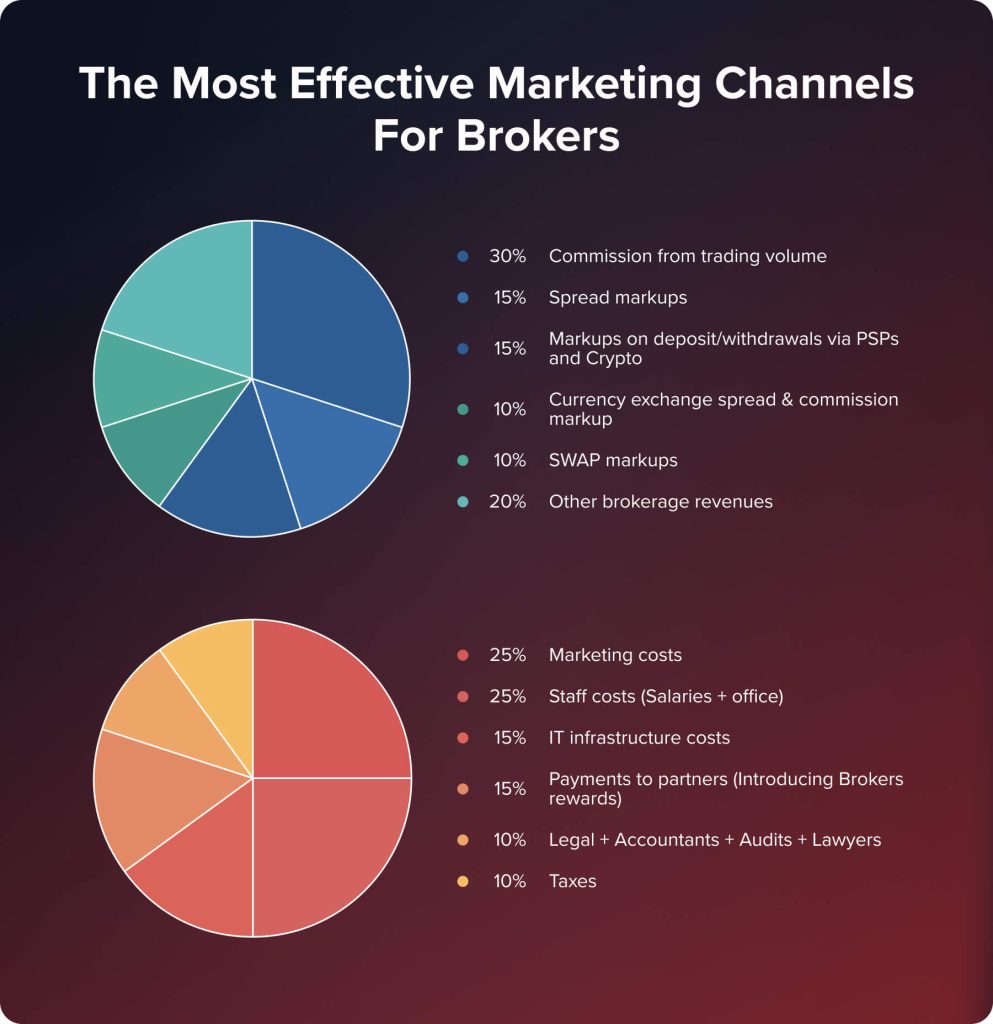
Устойчивая стратегия компании в индустрии Forex зависит от знания источников дохода и видов расходов до начала работ. Независимо от конкретной операционной модели, у Forex-брокеров есть множество способов зарабатывать деньги и справляться с разными текущими расходами компании.
Источники доходов Forex-брокеров
- Комиссии и спреды: основной источник дохода Forex–брокеров — это комиссия за сделки и спред, разница между ценами покупки и продажи валютных пар. Брокерские конторы зарабатывают, увеличивая эти спреды или взимая комиссию с каждой совершенной сделки.
- Доходы B-Book: в модели B-Book брокер выступает в качестве контрагента сделкам клиентов, по сути, делая ставки против них. Это означает, что когда клиенты теряют свои сделки, брокерская компания получает прибыль. Но тут есть момент управления рисками, поскольку крупные выигрыши клиентов могут повлиять на финансы брокерской компании.
- Дополнительные услуги: многие брокерские конторы увеличивают свой доход с помощью дополнительных услуг: премиальных торговых инструментов, образовательных ресурсов, управления счетами или услуги VPS (виртуального частного сервера) для более эффективной торговли.
- Комиссия за своп: брокерские компании также могут зарабатывать на комиссии за своп — комиссий или кредитов, начисляемых на счета за удержание позиций в течение ночи. Они основаны на разнице процентных ставок между торгуемыми валютами.
- Комиссия за конвертацию валюты: если брокерская компания предоставляет мультивалютные счета, внесение депозитов или снятие средств клиентами в других валютах приведет к расходам на перевод валюты.
Расходы, связанные с управлением брокером на рынке Forex
- Операционные расходы и расходы на персонал: ежедневное функционирование прибыльной брокерской компании влечет за собой ряд операционных расходов, в том числе оплату для трейдеров, аналитиков, агентов службы поддержки и IT-поддержку.
- Технологии и инфраструктура: платформы для торговли на рынке Forex, обслуживание серверов и IT-инфраструктура — необходимость для эффективных и безопасных торговых операций — занимают значительную часть бюджета на техническую составляющую.
- Маркетинг и реклама: брокерские компании вкладывают значительные средства в маркетинг и рекламу, чтобы привлечь и удержать клиентов. Сюда входит интернет-маркетинг, партнерские программы и рекламные мероприятия.
- Юридические расходы и соблюдение нормативных требований:обеспечение нормативного контроля требует платы за лицензирование, юридические консультации, работу персонала по соблюдению нормативных требований, а также за постоянную подачу нормативных документов и аудит.
- Управление рисками: управление торговыми рисками клиентов, особенно для брокеров B-Book, может привести либо к расходам на хеджирование операций клиентов на рынке, либо на применение внутренних методов управления рисками.
Чтобы гарантировать прибыльность и устойчивость на конкурентном валютном рынке, успешная Forex-компания эффективно балансирует источники доходов и расходы, тем самым приспосабливаясь к динамике рынка и требованиям клиентов.
Сравнение запуск с нуля vs. решение White Label
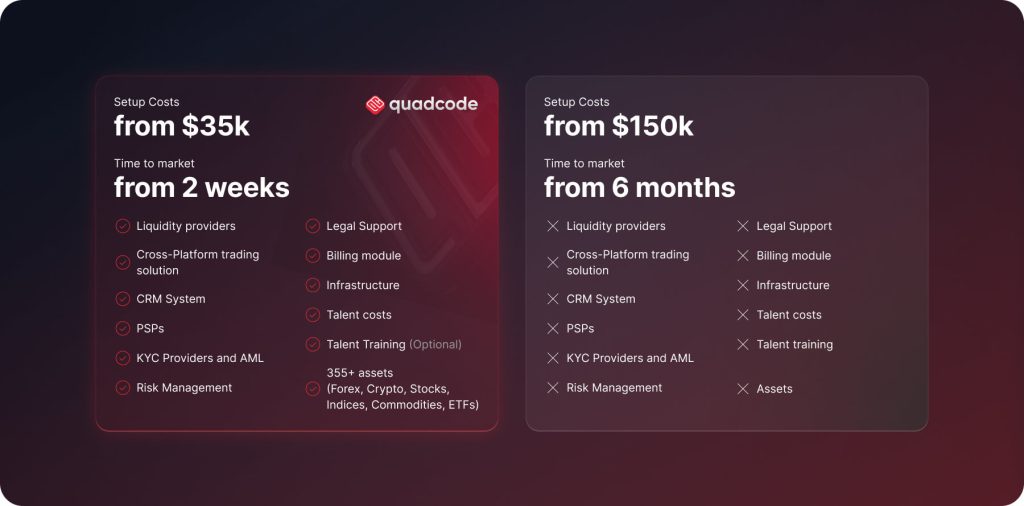
В конкурентной среде Forex-компаний решающее значение имеет выбор между запуском с нуля и решением white label. Хотя каждый подход имеет свои преимущества, решение white label представляется явно более выгодным вариантом, особенно с точки зрения затрат, экономии времени и простоты эксплуатации.
Запуск с нуля: дорогостоящее и трудоемкое предприятие
Создание Forex-брокера с нуля дает полный контроль и возможности для глубокой настройки. Однако этот путь сопряжен со значительными финансовыми и временными затратами. Затраты на разработку собственной торговой платформы, получение лицензий, обеспечение нормативного соответствия и создание IT-инфраструктуры могут вырасти очень быстро. Кроме того, сроки запуска полнофункциональной брокерской компании с нуля растягиваются на несколько месяцев, если не лет. Такой длительный период разработки может стать критическим недостатком на быстро развивающемся рынке Forex.
Решение White Label: доступный и быстрый выход на рынок
С другой стороны, работа с Forex-провайдером white label — это более доступный способ развернуть брокера. Обычно затраты на создание брокерской компании white label составляют от 10 000 до 70 000 долларов, что намного меньше затрат на создание брокера с нуля. Такая доступность позволяет большему количеству владельцев небольших компаний и предпринимателей выйти на валютный рынок.
Пожалуй, самая привлекательная особенность продукта white label — быстрота реализации. Forex-брокер White label Forex может запуститься и начать работу за несколько недель, что позволяет быстро войти на рынок. Такое быстрое развертывание имеет решающее значение в заработке на текущих рыночных возможностях и закреплении в этом секторе без значительных задержек, связанных с открытием брокера с нуля.
Еще одно важное преимущество систем white label — простота в эксплуатации. Снимая большую часть технической и юридической нагрузки, они позволяют брокеру сосредоточиться на привлечении клиентов, улучшении сервиса и построении бренда. Хотя персонализация может быть несколько ограниченной по сравнению со своим решением, большинство систем white label обеспечивают достаточную гибкость и функциональность для обеспечения уверенного позиционирования на рынке. Заинтересовавшиеся могут ознакомиться с такими инструментами, как вебинар «Как запустить брокера с нуля», чтобы лучше понять, как использовать брокера White label. Этот вебинар познакомит вас с ключевыми этапами и проблемами создания прибыльной Forex-брокера white label, предоставит полезную информацию и практические советы.
Заключение
Открытие брокера на рынке Forex в 2025 году — сложный, но потенциально прибыльный бизнес. Внимательно прочитав и применив рекомендации, вы заложите фундамент для создания прибыльного Forex-брокера. Независимо от того, начинаете ли вы с нуля или полагаетесь на решения white label, секрет успеха заключается в стратегическом планировании, знании рынка и соблюдении нормативных требований.
Обновлено:
1 апреля 2025 г.



